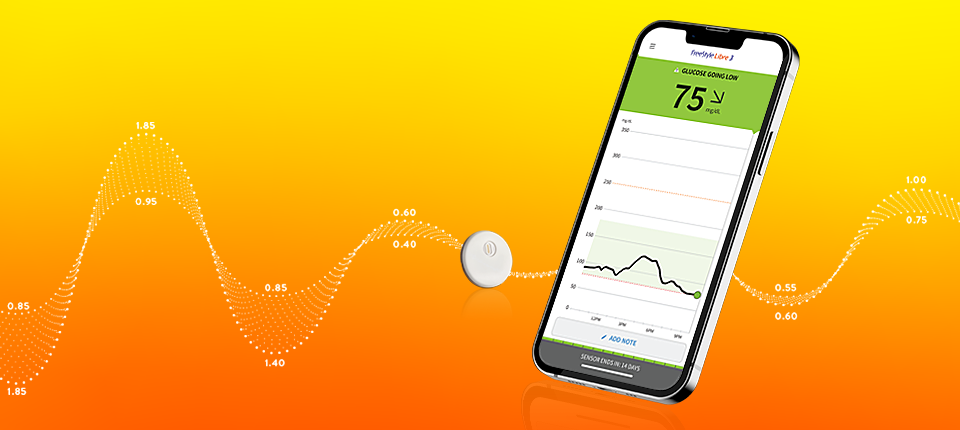
Dual Diabetes Sensors v. DKA: A Fight to the Future
Diabetic ketoacidosis lurks in the shadows where an innovative dual glucose-ketone sensor hopes to shine some light.
June 21, 2022
- Copy Link
- Share on X
- Share on Facebook
- Share on Linkedin
Some things just sound bad.
Real bad.
Like diabetic ketoacidosis (DKA). There is nothing in those ten syllables that hints of good times or optimal outcomes. Nor should there be, because DKA is serious business, often leading to hospital admissions, intensive care unit (ICU) stays and even death.
But other things just sound good.
Real good.
Like the continuous glucose-ketone monitor Abbott is developing to help reduce how often DKA episodes occur and the damage they can cause.
With this innovation, our monitors will be the only continuous glucose monitor (CGM) capable of measuring two analytes on the same sensor.
We spoke to one of Abbott's top diabetes experts to learn more about DKA, its impact on people and medical systems and the possible benefits of a dual glucose-ketone monitor.
What Is DKA?
DKA is a potentially life-threatening condition in which ketone numbers rise to dangerous levels in the blood. "The way the body works is that cells have a way of letting blood sugar (glucose) into them. There is a door between the cell and the blood and insulin is the key that opens that door. Insulin allows the cell to "see" the glucose and use it as a fuel source," said Dr. Mahmood Kazemi, divisional vice president, medical and scientific affairs and chief medical officer, Diabetes Care, Abbott.
"If you don't have insulin, that glucose can't get into the cell. It's like being outside your house without a key to get in. So, there could be a lot of glucose out in the blood, but inside the cell, it does not appear there is. Naturally, this impacts people with type 1 diabetes to a greater degree because they have no insulin, as opposed to type 2, where there is merely an insulin deficiency.
"While most of your body can find alternative fuel sources, the brain cells are pickier. The only two fuel sources they will let in are glucose and ketones. So when the lack of insulin hides the presence of glucose, the body generates ketones in an effort to feed the brain. The problem is that as more ketones are generated, blood pH starts going down, causing acidity to rise. Ketones can be toxic and high levels can poison the body."
How Do People with Diabetes Not Get an Adequate Amount of Insulin?
"The way people die today of DKA is that they are not getting enough insulin. If they have adequate amounts of insulin, the glucose will be "seen" within the cell and used as fuel. There are various reasons insulin levels might be dangerously low. In some cases, people are intentionally underdosing, which happens in the U.S. for many reasons, including cost,"said Dr. Kazemi. "People know they should be using more, but because of the expense they are rationing it and, therefore, are often on the edge of going into DKA.
"Another issue is that some people, often young people, want a certain body weight, and if you give yourself some insulin, but not enough, you can maintain a desired weight. So these people are teetering on the edge of DKA to have the weight they want.
"The third reason is that people on insulin pumps can get kinks in the tubing that restrict flow, or the pump may not be properly inserted, so the insulin may not be getting to the patient in the desired amount, leading to an accidental underdosing of insulin."
How Serious a Problem is DKA?
Very serious and growing.
In 2016, there were 203,000 emergency room visits and 188,000 hospitalizations for DKA (the latter up from 118,800 in 2003).1, 2 The seriousness of DKA episodes can be seen in the fact that while there were considerably more hypoglycemia (low blood sugar) related emergency room visits in 2016 (235,000 to the 203,00 noted above), the number of hospitalizations required for DKA was over three times higher.
In addition to the medical impact on people with diabetes, the costs associated with DKA have also risen in the U.S., with total costs increasing from $2.2 billion in 2003 to $5.1 billion in 20142. DKA patients often require in-patient stays, with many involving ICU admissions because they need IV fluids to treat volume depletion, replace electrolytes, get IV insulin treatment until the acidosis disappears, and/or address whatever underlying cause may be involved.3
Why Don't People Just Use Ketone Strips to Determine if Their Numbers are Dangerously Elevated?
"People do currently use ketone test strips in the U.S., but not commonly," said Dr. Kazemi. "You would only use them if you were symptomatic and by the time a person is feeling sick, the situation may already be cascading. There are additional problems like they are relatively expensive, often not covered by insurance and they may well expire before the average person has used their allotment."
What is the Advantage of Having a Glucose-Ketone Sensor as Part of a CGM System?
"The sensor would theoretically catch the impending DKA before one would experience symptoms," said Dr. Kazemi. "As with glucose, it would tell me a situation is developing before the symptoms appear and I could act on those findings before they became an issue. Did I not give myself enough insulin? Is there a problem with my pump?
"There is data to suggest that ketones rise before glucose does, which could give an earlier indicator that one is having a problem with insulin delivery. Ketone numbers below 0.6 do not rate attention and over 1.5 they are considered elevated. One could get an indication when ketones are between 0.6 and 1.5 that the ketones are on their way to DKA before they would show up on a person’s glucose numbers."
Who Would Benefit from Using a Continuous Glucose-Ketone Sensor or Monitoring System?
"Anyone who could suffer from DKA could benefit from such a device," said Dr. Kazemi. "Anyone with type 1 is at risk, but we also know that children and young adults are more likely to suffer from DKA. Pregnancy is also a risk factor. If you think of a profile of people who are at risk for DKA, that is a large group.
"To get a ballpark estimate, take all type 1s, add pregnant women and a certain percentage of type 2s who are taking SGLT2 inhibitors. There are also type 2s who are not at risk for DKA but are using it as a medication or as part of a certain diet who could benefit from the sensor results."
Sounding Better All the Time
Some things just sound bad.
Chronic condition. Fear of the unknown. Anticipatory anxiety.
Some things just sound good.
Medical technology. Hope. Embracing the future.
References
1 National Diabetes Statistics Report 2020, Estimates of Diabetes and Its Burden in the united States (2020) https://www.cdc.gov/diabetes/pdfs/data/statistics/national-diabetes-statistics-report.pdf
2 Desai et al. Diabetes Care (2018): 10.2337/dc17-1379
3 Gosmanov et al. Diab, Met. Syndrome, and Obesity (2014): 10.2147/DMSO.S50516
Related articles
-
Strategy and Strength
FreeStyle Libre 3: Welcome to the U.S.
Abbott takes diabetes management to the next level in the U.S. with its next-gen continuous glucose monitor.
-
Diabetes Care
More Time in Range With Our Diabetes Care App
Data show people who use a FreeStyle LibreLink glucose monitor app spend more time in range.   ,
For the latest on Abbott’s life-changing technology, get updates directly in your inbox.

